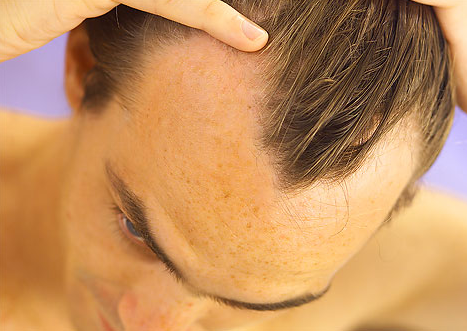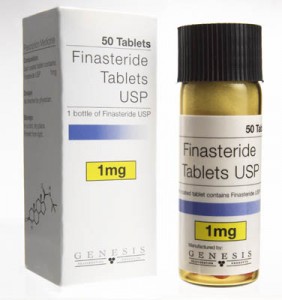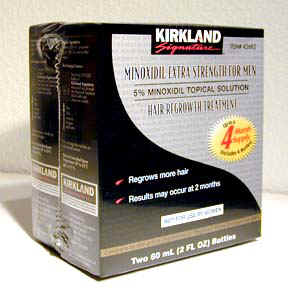Posts Tagged ‘shock loss’
Tuesday, February 21st, 2012
 We receive a lot of questions at US Hair Restoration about the use of Minoxidil (Rogaine), and how it affects hair growth after a hair transplant procedure. There are mixed reviews people find on the internet through different websites and blogs about the Foam version of Rogaine. Some say it helps hair growth, others say it hinders, while some claim it does absolutely nothing. We receive a lot of questions at US Hair Restoration about the use of Minoxidil (Rogaine), and how it affects hair growth after a hair transplant procedure. There are mixed reviews people find on the internet through different websites and blogs about the Foam version of Rogaine. Some say it helps hair growth, others say it hinders, while some claim it does absolutely nothing.
Minoxidil (Rogaine) may be used after a hair transplantation on the newly transplanted area, for protecting the already existing hairs which are genetically predisposed to thinning. The hair grafts which are actually transplanted from the donor area require no medication for growth and maintain a permanent residence in the balding area. Those are the healthy hairs which are not affected by the hormone DHT (Dehydrotestosterone) which causes thinning and baldness.
 There may be some loss of existing native hair in the balding area due to shock loss, and for this we recommend Propecia for male patients to protect against. Propecia is proven to work better then Rogaine for the prevention of shock loss in men, and continues to have remarkable results in the patients who use the medication as directed. Unfortunately it does not work on women, but in these cases Rogaine does work and is a recommend option for the first few months after hair restoration surgery. There may be some loss of existing native hair in the balding area due to shock loss, and for this we recommend Propecia for male patients to protect against. Propecia is proven to work better then Rogaine for the prevention of shock loss in men, and continues to have remarkable results in the patients who use the medication as directed. Unfortunately it does not work on women, but in these cases Rogaine does work and is a recommend option for the first few months after hair restoration surgery.
Tags: female hair loss, finasteride, Male Hair Loss, minoxidil, propecia, rogaine, shock loss
Posted in after hair transplant, hair loss complications, hair loss medication, men hair restoration, women hair loss | No Comments »
Sunday, May 2nd, 2010
 Q: Q:
I started the Propecia at the beginning of March (8 months ago), prior to the procedure last March. Should I still be on it?
A:
It is great to hear from you and I am glad you are happy with the result of your hair transplant. The final result of your hair may still get better up until one full year after your surgery if you allow your hair on the transplanted area to grow longer.
Finasteride as a hair loss medication was mostly prescribed for prevention of shock loss or losing native hair on the balding areas after a hair transplant. You have significant miniaturization on the front, top and crown area (90%-100%), which makes your preexisting hair on balding areas prone to further hair loss. Now that you had your transplanted hair grown, you can decide to stop Propecia. By doing that, you may risk losing your own hair on the balding area further (transplanted hair does not need Propecia for its growth) or you can continue taking the medication to increase the longevity of your preexisting hair on those areas.
Tags: after hair transplant, finasteride, propecia, shock loss
Posted in hair loss medication, hair loss products, hair transplant, men hair restoration | No Comments »
Saturday, April 10th, 2010
Q:
Several weeks have passed since my hair transplant surgery. It has come to my attention that there’s a small bald spot near my left ear. As told, I was keeping that area clean the last few weeks, but no hair has grown back, it is still the same. I do not think it is getting larger. For some reason, the bald area is more sensitive to heat or cold temperatures. I was washing my hair today, and a scab fell off, but it was about the same size as the bald spot.
Another thing, I feel numb in the surrounding area of the bald spot. For me, I’ve never seen a bald spot in my donor wound until now. I’m wondering what I can do about it. I guess trauma leads to falling out of hair in donor wound areas as well. Just to let you know, I’ve been taking doses of finasteride daily, before, during the time I had surgery, and after surgery. Comparing to times past, I think I’ve taken pretty nice care of my head vs. the other times I had hair transplant surgeries, so I’m a bit concerned.
I wonder if the hair will ever grow back, as long as there isn’t a scar over it. My bald spot is about the size of a silver dollar; it looks quite noticeable. The bald spot has been overly sensitive the whole time after the surgery, but it wasn’t infected and there was no blood oozing out of it. I’m thinking that maybe the hair surrounding the wound fell off because of shock.
Your advice would be much appreciated,
A:
I appreciate the email. You guessed right about the hair loss probably being caused by shock around the area of your donor wound. There must have been really tight close-up of the donor area. Maybe the hard close-up caused the shock loss. The two areas, on either side of the scalp, are very vulnerable to shock loss. Usually, when shock loss occurs, it happens on both sides. Shock loss occurring around a donor wound is, most of the time, reversible. It takes about six months for hair lost because of shock loss to grow back. It’s a slow, but certain process. Stay patient.
At this time, there is not a lot that can be done. But it is important that a doctor takes a look at your shock loss. Also, the feeling of numbness in the donor area will last up from a few weeks to months. The numbness is caused by inflaming of the healing area, this has an effect on the nerves in that area. It will heal on its own time.
Tags: donor hair transplant, donor wound after hair transplant, hair restoration and donor scar, shock loss
Posted in hair loss complications, hair transplant, Uncategorized | No Comments »
Saturday, January 9th, 2010

The possibility of restoring hair loss through alternative hair restoration options such as by using finasteride or Rogaine is an issue some people may be wondering about. Although hair restoration through these shortcut methods (without a hair transplant procedure) might be OK for some people, I can’t advocate it as a full-fledged solution. Advertisements may try to sway you into believing it is the answer.
Today, FDA has OK’d certain medications for hair loss prevention: finasteride and minoxidil. I must say, both are legitimate treatments, but they may have various indications for a male and female baldness pattern. But they are not, I repeat, they are not a cure-all solution for male patterned baldness, as other pharmacy industry experts may try to get you to believe.
A hair transplant ought to be thought of as a preventive agent, along with other alternativest. And also as vital part of a bigger plan on looking your best. A lot of men and women experience shock loss after a hair transplant surgery; these people are required to try preventative measures like finasteride, at least a month or two before the hair transplant.
Since hair restoration surgery started (in the 1990s) and until recently, when a hair restoration surgery was done, shock loss had been a significant issue hair transplant patients had to deal with.
But these days, a good majority of patients go on finasteride after a hair transplant surgery.
Tags: fda, finasteride, hair loss treatment, medical hair restoration, minixidil, prevention of balding, shock loss
Posted in Bakersfield hair transplant, California hair transplant, hair loss medication, hair loss products, Newport Beach hair transplant, Orange County hair transplant | No Comments »
Saturday, June 20th, 2009
A recent patient of ours is looking into lowering her hairline to give her a more feminine and youthful frame for her face. She was a bit concerned when she read on our site that not many female hair loss patients are good candidates for hair restoration surgery. Her concerns also included the probability of losing her newly transplanted hair, recovery time and if hair restoration surgery has any negative effect on the body itself.
Hair transplant surgery is a very useful procedure for those whom have lost a significant amount of hair.
One question many patients have asked our facility is, “How do I know if I’m a good hair transplant candidate?”. Of the many patients whom are most concerned are our female hair loss patients. Women with significant miniaturization or thinning of hair shafts associated to female pattern baldness are not good candidates for the surgery. On the topic of hair line lowering, as long as the donor area has not been compromised by female pattern hair loss it is possible to do the surgery.
Hair transplant surgery is a permanent and safe procedure for both men and women. In some cases, patients may experience some degree of shock loss or loss of native hair after the hair transplant procedure. This is sometimes seen in patients whom have a high level of miniaturization as is seen in male or female pattern baldness.
Recovery time does vary for each patient but it is not enough to limit your everyday function. Most patients can go back to school or work the next day after their surgery and can conceal their transplant easily with a hat, head cover or by combing their hair in a different style temporarily. The most common residual effect is generally swelling and redness at the recipient area. This is usually resolved within or after 3-4 days from surgery. Most clinics, like ours, will provide our patients with special medication to alleviate these symptoms.
Hair restoration surgery does not have any adverse effect on the rest of the body. The most that can result from hair transplant surgery is primarily in regards to the induced medications the day of surgery. We always recommend that you disclose any allergic reactions possibly associated to medications and to food to prevent any complications or even discomfort during or after the procedure. Hair transplant surgery is considered a minimally invasive procedure and the possibility of it having a negative effect on the body are considered unlikely.
Tags: complications after surgery, hair transplant, hairline lowering procedure, miniaturization, redness after hair transplant, shock loss, swelling after hair transplant
Posted in after hair transplant, California hair transplant, hair transplant, women hair loss | No Comments »
|
|
 We receive a lot of questions at US Hair Restoration about the use of Minoxidil (Rogaine), and how it affects hair growth after a hair transplant procedure. There are mixed reviews people find on the internet through different websites and blogs about the Foam version of Rogaine. Some say it helps hair growth, others say it hinders, while some claim it does absolutely nothing.
We receive a lot of questions at US Hair Restoration about the use of Minoxidil (Rogaine), and how it affects hair growth after a hair transplant procedure. There are mixed reviews people find on the internet through different websites and blogs about the Foam version of Rogaine. Some say it helps hair growth, others say it hinders, while some claim it does absolutely nothing. There may be some loss of existing native hair in the balding area due to shock loss, and for this we recommend Propecia for male patients to protect against. Propecia is proven to work better then Rogaine for the prevention of shock loss in men, and continues to have remarkable results in the patients who use the medication as directed. Unfortunately it does not work on women, but in these cases Rogaine does work and is a recommend option for the first few months after hair restoration surgery.
There may be some loss of existing native hair in the balding area due to shock loss, and for this we recommend Propecia for male patients to protect against. Propecia is proven to work better then Rogaine for the prevention of shock loss in men, and continues to have remarkable results in the patients who use the medication as directed. Unfortunately it does not work on women, but in these cases Rogaine does work and is a recommend option for the first few months after hair restoration surgery.

